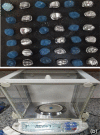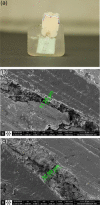Comparison of internal fit of metal-ceramic crowns in CAD/CAM and lost-wax techniques in all fabrication stages through replica weighting, triple scanning, and scanning electron microscope
- PMID: 35187813
- PMCID: PMC9209789
- DOI: 10.1002/cre2.529
Comparison of internal fit of metal-ceramic crowns in CAD/CAM and lost-wax techniques in all fabrication stages through replica weighting, triple scanning, and scanning electron microscope
Abstract
Objectives: Restoration fit is one of the prerequisites of clinical durability. It is controversial as to whether computer-assisted design/computer-aided milling (CAD/CAM) or lost-wax fabrication methods result in more fit metal-ceramic crowns. This in-vitro study was conducted to examine the internal fit of porcelain fused to metal crowns fabricated using CAD/CAM and lost-wax techniques during fabrication stages (framework, porcelain, cementation) through digital triple scanning, replica weighting, and observation with electron microscopy.
Material and methods: Twenty uniform resin dies of prepared first maxillary molars were randomly divided into two groups according to the fabrication technique: lost wax and CAD/CAM. The internal fit was measured in all steps of completing the crowns (framework, porcelain, and cementation) using different methods, including triple scanning, replica weighting, and scanning electron microscopy. The data were statistically analyzed using t test, Pearson, and repeated measures analysis of variance (α = .05).
Results: Triple scanning revealed no difference in the internal fit of CAD/CAM and lost-wax groups in all the fabrication steps (p > .05). The replica weighting method showed no difference between groups in the framework step (p > .05), while the internal fit was significantly better in the CAD/CAM group after porcelain application (p < .05). After cementation, electron microscopy measurements showed no difference between CAD/CAM and lost wax groups (p > .05). The Pearson correlation test showed no significant correlation between electron microscopy, replica weighing, and triple scanning methods (p > .05).
Conclusion: According to scanning electron microscopy as the superior evaluation method, the internal fit of cobalt-chrome PFM crown of both CAD/CAM and lost wax groups was within the acceptable clinical range and there was no significant difference between them. Triple scanning revealed no difference in the internal fit of framework and porcelain steps but a better fit after cementation. According to replica weighting, the internal fit in the porcelain step was higher than the framework.
Keywords: CAD/CAM; internal fit; lost wax; metal ceramic alloys.
© 2022 The Authors. Clinical and Experimental Dental Research published by John Wiley & Sons Ltd.
Conflict of interest statement
The authors declare that there are no conflict of interests.
Figures





Similar articles
-
Comparison of the marginal discrepancy of PFM crowns in the CAD/CAM and lost-wax fabrication techniques by triple scanning.Dent Med Probl. 2020 Oct-Dec;57(4):417-422. doi: 10.17219/dmp/125532. Dent Med Probl. 2020. PMID: 33444489
-
Internal fit of single crowns produced by CAD-CAM and lost-wax metal casting technique assessed by the triple-scan protocol.J Prosthet Dent. 2017 Mar;117(3):400-404. doi: 10.1016/j.prosdent.2016.06.017. Epub 2016 Sep 28. J Prosthet Dent. 2017. PMID: 27692584
-
Effect of porcelain firing and cementation on the marginal fit of implant-supported metal-ceramic restorations fabricated by additive or subtractive manufacturing methods.J Prosthet Dent. 2020 Oct;124(4):476.e1-476.e6. doi: 10.1016/j.prosdent.2020.03.014. Epub 2020 May 22. J Prosthet Dent. 2020. PMID: 32451142
-
Evaluation of marginal and internal fit of lithium disilicate and zirconia all-ceramic CAD-CAM crowns using digital impressions: A systematic review.Prim Dent J. 2023 Mar;12(1):88-95. doi: 10.1177/20501684231154323. Prim Dent J. 2023. PMID: 36916623
-
CAD/CAM systems available for the fabrication of crown and bridge restorations.Aust Dent J. 2011 Jun;56 Suppl 1:97-106. doi: 10.1111/j.1834-7819.2010.01300.x. Aust Dent J. 2011. PMID: 21564120 Review.
Cited by
-
Marginal and Internal Adaptation of Implant-Supported Three-Unit Metal Frameworks Fabricated by the Conventional, Semi-Digital, and Fully Digital Techniques Before and After Porcelain Application.Clin Exp Dent Res. 2025 Aug;11(4):e70173. doi: 10.1002/cre2.70173. Clin Exp Dent Res. 2025. PMID: 40631981 Free PMC article.
References
-
- ADA Science & Research Institute . (2021, February 9). Materials for indirect restorations. Retrieved December 2021, from https://www.ada.org/en/member-center/oral-health-topics/materials-for-in...
-
- Bicer, A. Z. , & Unver, S. (2018). Etiology of secondary caries in prosthodontic treatments. Dental Caries‐Diagnosis, Prevention and Management, 10, 35–54.
-
- Dahl, B. E. , Dahl, J. E. , & Rønold, H. J. (2018a). Digital evaluation of marginal and internal fit of single‐crown fixed dental prostheses. European Journal of Oral Sciences, 126, 512–517. - PubMed
-
- Dahl, B. E. , Dahl, J. E. , & Rønold, H. J. (2018b). Internal fit of three‐unit fixed dental prostheses produced by computer‐aided design/computer‐aided manufacturing and the lost‐wax metal casting technique assessed using the triple‐scan protocol. European Journal of Oral Sciences, 126, 66–73. - PubMed
-
- Dahl, B. E. , Rønold, H. J. , & Dahl, J. E. (2017). Internal fit of single crowns produced by CAD‐CAM and lost‐wax metal casting technique assessed by the triple‐scan protocol. Journal of Prosthetic Dentistry, 117, 400–404. - PubMed
Publication types
MeSH terms
Substances
LinkOut - more resources
Full Text Sources
Miscellaneous

